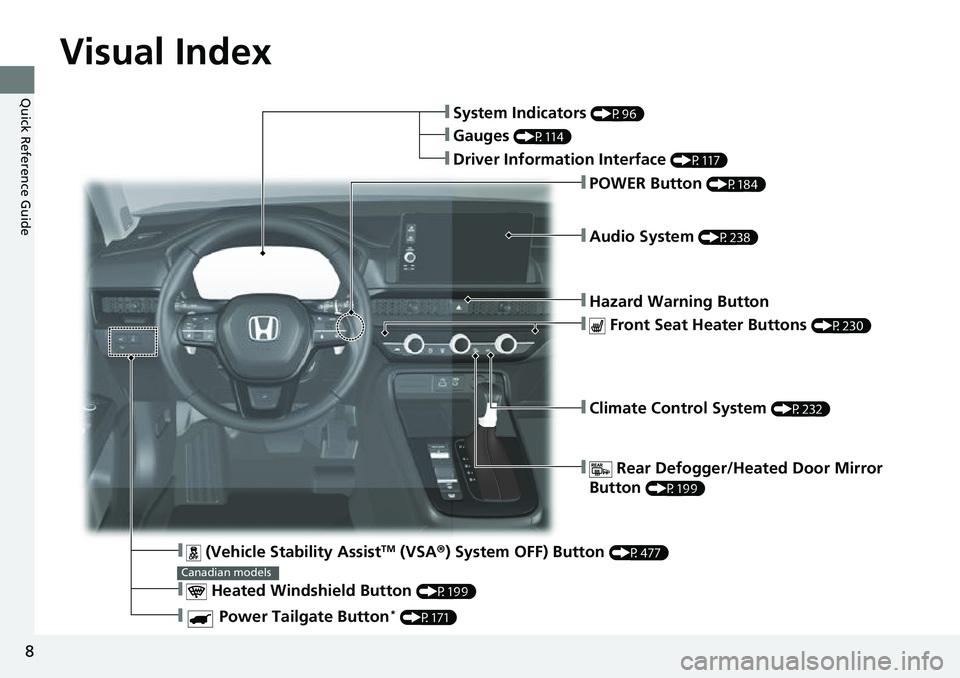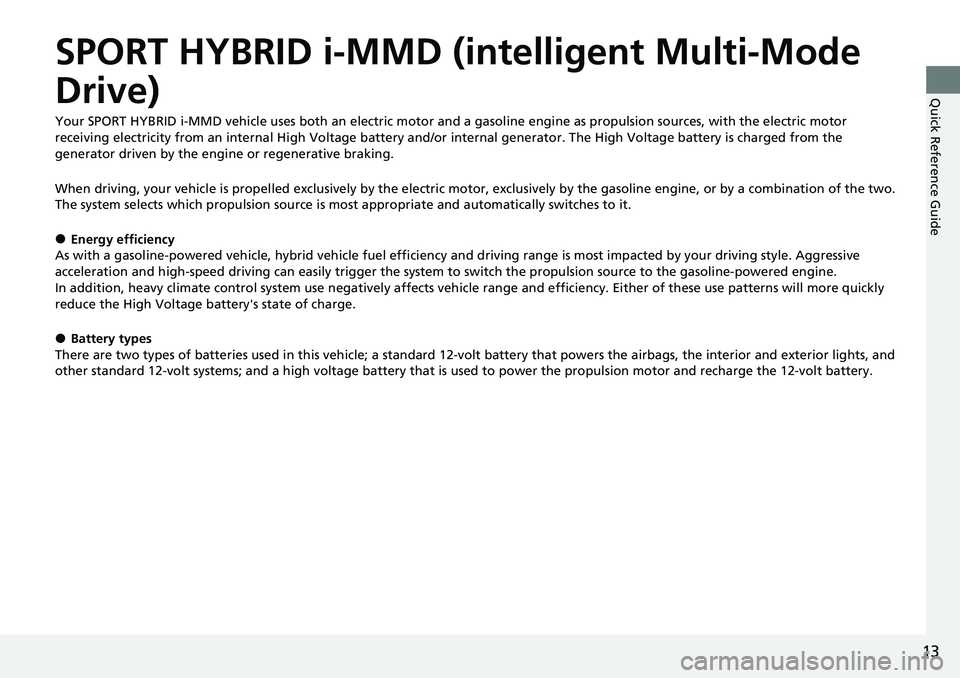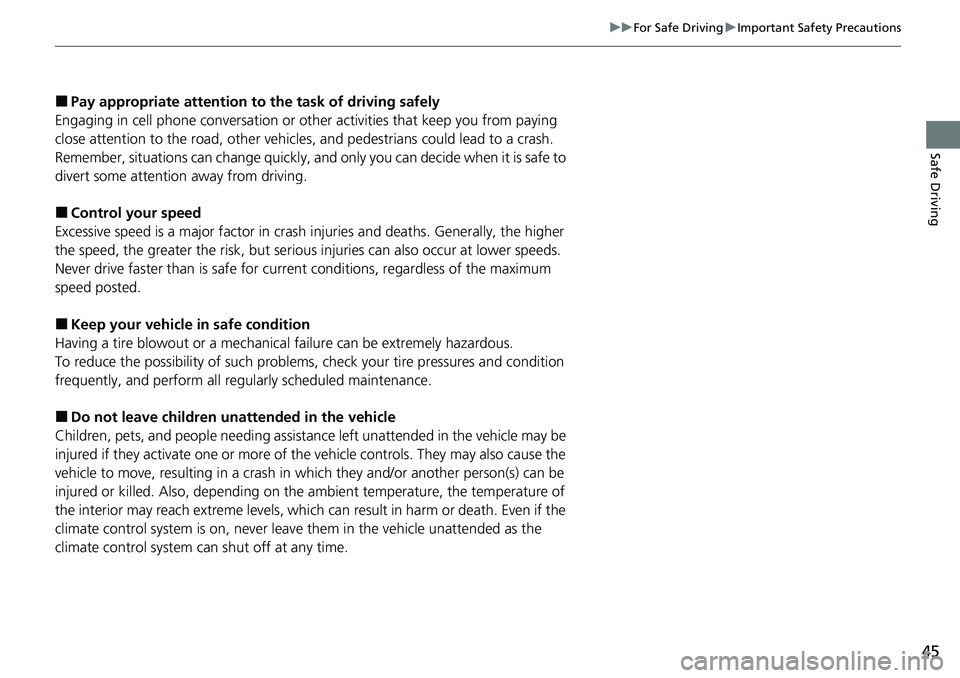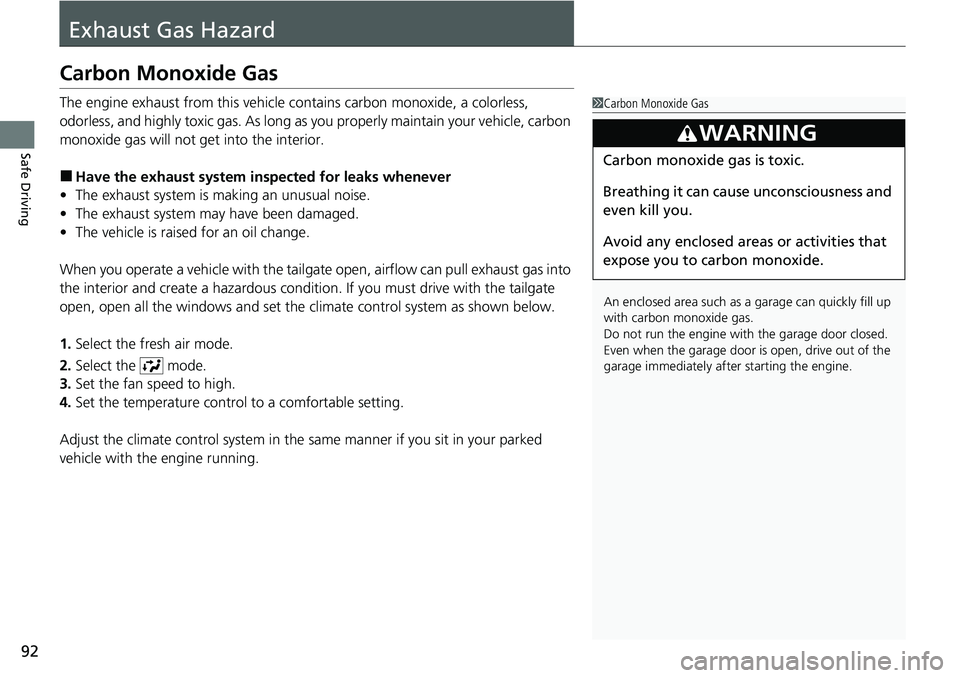2023 HONDA CRV climate control
[x] Cancel search: climate controlPage 7 of 719

Contents
This owner’s manual should be considered a permanent part of the
vehicle and should remain with the vehicle when it is sold.
The Navigation Manual is available online at owners.honda.com
(U.S.) or honda.ca (Canada). If you are the first registered owner
of your vehicle, you may request a complimentary printed
copy of the Navigation Manual within the first six months of
vehicle purchase. To request a copy, visit owners.honda.com. In
Canada, please request a copy from your Honda dealer.
This owner’s manual covers all models of your vehicle. You may find
descriptions of equipment and features that are not on your
particular model.
Images throughout this owner’s ma nual (including the front cover)
represent features and equipment that are available on some, but
not all, models. Your particular mo del may not have some of these
features.
This owner’s manual is for vehicles sold in the United States and
Canada.
The information and specifications in cluded in this publication were
in effect at the time of approval for printing. Honda Motor Co., Ltd.
reserves the right, however, to discontinue or change specifications
or design at any time without notice and without incurring any
obligation.2 Safe Driving P. 43
For Safe Driving P. 44 Seat Belts P. 49 Airbags P. 59
2Instrument Panel P. 95
Indicators P. 96 Gauges and Driver Information Interface P. 114
2Controls P. 145
Clock P. 146 Locking and Unlocking the Doors P. 148
Moonroof P. 183
Seats P. 205 Interior Convenience Items P. 216
2Features P. 237
Audio System P. 238 Audio System Basic Operation P. 246, 271
Customized Features P. 368, 376
2 Driving P. 441
Before Driving P. 442 Towing a Trailer P. 447Parking Your Vehicle P. 582 Multi-View Rear Camera P. 593
2Maintenance P. 599
Before Performing Maintenance P. 600 Maintenance MinderTM P. 603
Checking and Maintaining Wiper Blades P. 627
Climate Control System Maintenance P. 643
2Handling the Unexpected P. 651
Tools P. 652 If a Tire Goes Flat P. 653
Shift Lever Does Not Move P. 673 Overheating P. 674
If You Cannot Unlock the Fuel Fill Door P. 690
2 Information P. 693
Specifications P. 694 Identification Numbers P. 696
Emissions Testing P. 699 Warranty Coverages P. 701
Page 8 of 719

Contents
Child Safety P. 79Exhaust Gas Hazard P. 92Safety Labels P. 93
Tailgate P. 165 Security System P. 176 Windows P. 179
Operating the Switches Around the Steering Wheel P. 184 Mirrors P. 203
Climate Control System P. 232
Audio Error Messages P. 345 General Information on the Audio System P. 347
Bluetooth ® HandsFreeLink ® P. 400, 420 Refuel Recommend P. 439
Off-Highway Driving Guidelines P. 453 When Driving P. 455 Honda Sensing ® P. 492 Braking P. 572
Refueling P. 595 Fuel Economy and CO
2 Emissions P. 598
Maintenance Under the Hood P. 611 Replacing Light Bulbs P. 623
Checking and Maintaining Tires P. 631 12-Volt Battery P. 640 Remote Transmitter Care P. 642
Cleaning P. 644 Accessories and Modifications P. 649
Handling of the Jack P. 666 Power System Won’t Start P. 667 If the 12-Volt Battery Is Dead P. 671
Indicator, Coming On/Blinking P. 676 Fuses P. 683 Emergency Towing P. 689
If You Cannot Open the Tailgate P. 691 Refueling P. 692
Devices that Emit Radio Waves P. 697 Reporting Safety Defects P. 698
Authorized Manuals P. 704 Customer Service Information P. 705 Open Source Licenses P. 706
Quick Reference GuideP. 8
Safe DrivingP. 43
Instrument PanelP. 95
ControlsP. 145
FeaturesP. 237
DrivingP. 441
MaintenanceP. 599
Handling the UnexpectedP. 651
InformationP. 693
IndexP. 708
Page 9 of 719

8
Quick Reference Guide
Quick Reference Guide
Visual Index
❚Climate Control System (P232)
❚ Rear Defogger/Heated Door Mirror
Button
(P199)
❚Audio System (P238)
❚System Indicators (P96)
❚Gauges (P114)
❚Driver Information Interface (P117)
❚POWER Button (P184)
❚Hazard Warning Button
❚ Heated Windshield Button (P199)
Canadian models
❚ (Vehicle Stability AssistTM (VSA ®) System OFF) Button (P477)
❚ Power Tailgate Button* (P171)
❚ Front Seat Heater Buttons (P230)
Page 14 of 719

13
Quick Reference Guide
SPORT HYBRID i-MMD (intelligent Multi-Mode
Drive)
Your SPORT HYBRID i-MMD vehicle uses both an electric motor and a gasoline engine as propulsion sources, with the electric motor
receiving electricity from an internal High Voltage battery and/or internal generator. The High Voltage battery is charged from the
generator driven by the engine or regenerative braking.
When driving, your vehicle is propelled exclusively by the electric motor, exclusively by the gasoline engine, or by a combination of the two.
The system selects which propulsion source is most appropriate and automatically switches to it.
●Energy efficiency
As with a gasoline-powered vehicle, hybrid vehicle fuel efficien cy and driving range is most impacted by your driving style. Aggressive
acceleration and high-speed driving can easily trigger the system to switch the propulsion source to the gasoline-powered engin e.
In addition, heavy climate control system use negatively affects vehicle range and efficiency. Either of these use patterns will more quickly
reduce the High Voltage battery's state of charge.
●Battery types
There are two types of batteries used in this vehicle; a standard 12-volt battery that powers the airbags, the interior and exterior lights, and
other standard 12-volt systems; and a high voltage battery that is used to power the propulsion motor and recharge the 12-volt battery.
Page 18 of 719

17
Quick Reference Guide
●Regenerative Energy and Regenerative BrakingWhen decelerating without the accelerator being depressed or the brake pedal being applied, or
while driving downhill, the electric motor acts as a generator that recovers a portion of the
electrical energy that was used to accelerate the vehicle. This regenerative braking slows the
vehicle in a manner similar to engine braking in a gasoline-powered vehicle. You can control the
rate of deceleration by using the deceleration paddle selector.
●Auto Engine Stop/Start
Your vehicle’s gasoline engine automatically stops running during vehicle operation or restarts while the vehicle is stationary when it is
appropriate.
In the following cases, however, auto engine stop may not activate.
•The vehicle momentarily needs additional power for aggressive acceleration, or driving uphill or at high speed.
•The climate control system is in heavy use.
•The High Voltage battery temperature is high or low.•The High Voltage battery is too low on charge.
Predictive Eco Assist*
Predictive Eco Assist helps you drive more economically to your destination during navigation route guidance.
It predicts how much the high voltage battery can be charged by regenerative braking when driving downhill on the way to the
destination, and operates in EV mode as much as possible.
If there are any stops on the way to the destination, it works more effectively if they are set as waypoints.
If you leave the suggested navigation route, Predictive Eco Assi st may not function in a way that is suitable for your route.
You can turn Predictive Eco Assist on and off in Ve hicle Settings using the audio/information screen.
2 Customized Features (P376)
When regenerative braking is in
operation
Motor
High
Voltage
Battery
* Not available on all models
Page 28 of 719

27
Quick Reference Guide
Climate Control System (P232)
●Press the AUTO button to activate th e climate control system.●Press the button to turn the system on or off.●Press the button to de frost the windshield.
Fan Control Dial
(Windshield Defroster) ButtonDriver’s Side Temperature
Control Dial (Recirculation) Button
(ON/OFF ) Button
AUTO Button A/C (Air Conditioning) Button
Dashboard
vent
s D
ashboard
and floor
vents Floor vents Floor and
defroster
vents
Passenger’s Side Temperature
Control D ial
SYNC Button
Page 46 of 719

45
uuFor Safe Driving uImportant Safety Precautions
Safe Driving
■Pay appropriate attention to the task of driving safely
Engaging in cell phone conversation or other activities that keep you from paying
close attention to the road, other vehicles, and pedestrians could lead to a crash.
Remember, situations can change quickly, and only you can decide when it is safe to
divert some attention away from driving.
■Control your speed
Excessive speed is a major factor in crash injuries and deaths. Generally, the higher
the speed, the greater the risk, but serious injuries can also occur at lower speeds.
Never drive faster than is safe for current conditions, regardless of the maximum
speed posted.
■Keep your vehicle in safe condition
Having a tire blowout or a mechanical failure can be extremely hazardous.
To reduce the possibility of such problems, check your tire pressures and condition
frequently, and perform all regul arly scheduled maintenance.
■Do not leave children unattended in the vehicle
Children, pets, and people needing assistance left unattended in the vehicle may be
injured if they activate one or more of the vehicle controls. They may also cause the
vehicle to move, resulting in a crash in wh ich they and/or another person(s) can be
injured or killed. Also, depending on the am bient temperature, the temperature of
the interior may reach extreme levels, which can result in harm or death. Even if the
climate control system is on, never leave them in the vehicle unattended as the
climate control system can shut off at any time.
Page 93 of 719

92
Safe Driving
Exhaust Gas Hazard
Carbon Monoxide Gas
The engine exhaust from this vehicle contains carbon monoxide, a colorless,
odorless, and highly toxic gas. As long as you properly maintain your vehicle, carbon
monoxide gas will not get into the interior.
■Have the exhaust system in spected for leaks whenever
• The exhaust system is m aking an unusual noise.
• The exhaust system may have been damaged.
• The vehicle is raised for an oil change.
When you operate a vehicle with the tailgat e open, airflow can pull exhaust gas into
the interior and create a hazardous conditio n. If you must drive with the tailgate
open, open all the windows and set the climate control system as shown below.
1. Select the fresh air mode.
2. Select the mode.
3. Set the fan speed to high.
4. Set the temperature control to a comfortable setting.
Adjust the climate control system in the same manner if you sit in your parked
vehicle with the engine running.
1 Carbon Monoxide Gas
An enclosed area such as a garage can quickly fill up
with carbon monoxide gas.
Do not run the engine with the garage door closed.
Even when the garage door is open, drive out of the
garage immediat ely after starting the engine.
3WARNING
Carbon monoxide gas is toxic.
Breathing it can cause unconsciousness and
even kill you.
Avoid any enclosed areas or activities that
expose you to carbon monoxide.